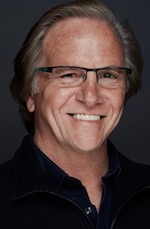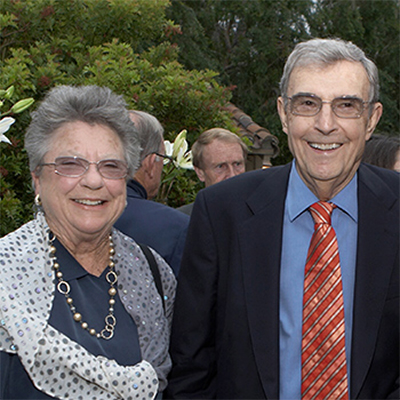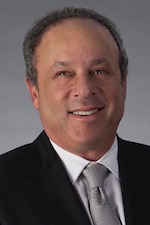Daily Business Report-Feb. 22, 2019
California public employee union membership, now 1.24 million, hovered at 55 percent in past years before declining to 50.3 percent in 2018. (Graphic from CALmatters)
Public sector union membership
in California is slipping
By Dan Morain | CALmatters
The percentage of public employee union members has dipped.
Although labor retains significant clout in California, the percentage of public employees who are union members dropped to 50.3 percent in 2018, the lowest percentage since 2000, according to data compiled by Unionstats.com.
It could be a blip. Or perhaps it’s fallout from last year’s U.S. Supreme Court decision, Janus vs. American Federation of State, County and Municipal Employees, which makes it easier for government workers to quit labor organizations.
The California Labor Federation’s Steve Smith said major public employee unions that are among the federation’s affiliates have not reported declines.
Smith: “It’s a bit of a mystery.”
California public employee union membership, now 1.24 million, hovered at 55 percent in past years before declining to 50.3 percent in 2018, said Colin Gordon, a University of Iowa history professor who researches such issues. Actual numbers fell by 125,634 members.
Gordon: “I don’t think that’s noise.”
Lobbying matters: In 2018, public employee unions’ spending on lobbying in Sacramento dipped, perhaps a reflection of the decrease in dues-paying members.
The California State Council of Service Employees, for example, spent $8 million in 2017-18, down from the $11.8 million in 2015-16 and the $8.67 million it spent in 2011-12 when it was the No. 1 spender.
Meanwhile in the private sector: Unions representing workers at private employers in California ticked up by 41,338, though the percentage of unionized private employer workers is a mere 8.3 percent.
_________________

Women’s Week Speaker Jennifer Eberhardt:
Biased —Uncovering the Hidden Prejudice that
Shapes What We See, Think, and Do
The topic of racial bias can be difficult and uncomfortable to discuss, often inspiring reactions of tribalism, resentment, blaming, and suspicion. But the potential for bias is present in all of us, and it is vital to understand how bias works in order to begin to correct its devastating effects in our society.
Unblinking about the tragic consequences of prejudice, Jennifer Eberhardt addresses how racial bias is not the fault of nor restricted to a few “bad apples” but is present at all levels of society in media, education, and business. The good news is that we are not hopelessly doomed by our innate prejudices. Eberhardt reminds us that racial bias is a human problem—one all people can play a role in solving.
Eberhardt will speak at the Leadership Conference April 5 as part of San Diego Women’s Week sponsored by North San Diego Business Chamber. Women’s Week runs April 1-5. Click here (https://sdwomensweek.com/events/leadership-conference/) for the schedule. Attendees will receive an autographed copy of Eberhardt’s new book, “Biased: Uncovering the Hidden Prejudice that Shapes What We See, Think, and Do.”
________________
SDG&E begins transitioning
customers to Time-of-Use Plans
As part of a California Public Utilities Commission initiative to support the state’s continuing shift to clean energy, San Diego Gas & Electric will begin to transition their residential customers to new Time-of-Use (TOU) pricing plans starting in March. Approximately 750,000 customers – roughly 75,000-100,000 per month – will be moved to TOU plans by mid-2020. These plans are designed to give customers more choices and control over their energy bills.
TOU plans offer customers two ways to save: by shifting electricity use to lower cost hours of the day, before 4 p.m. or after 9 p.m., and/or by reducing overall usage. TOU plans are designed to encourage a cleaner power grid by using energy when renewable resources, like solar power, are readily available.
SDG&E began communicating with the first ~100,000 customers three months prior to them transitioning to their new plan. Direct mail and emails were distributed to the customers notifying them of the transition and included tips and other information about their new plan. Throughout the year, as more customers are transitioned, SDG&E will continue to distribute direct mail and email notifications, and information via multiple communications channels, including social media, TV, radio, and print.
“The transition to Time-of-Use plans marks a big milestone in California’s journey toward a clean energy future,” said SDG&E vice president of customer services Scott Crider. “We are committed to helping our customers through this transition.”
Small shifts in electricity use can make a big difference. By running the dishwasher or doing laundry during off-peak hours, customers can benefit from lower prices when enrolled in a TOU plan. Customers who use high amounts of energy due to air conditioners, pool pumps and other devices can lower their monthly bills if they are able to shift the operation of those devices outside of 4 p.m. to 9 p.m. More tips can be found at sdge.com/whenmatters.
Existing customers who are transitioning can try a new TOU plan risk-free for up to one year. If they end up spending more on energy than when they were on their original plan, they will receive a bill credit for the difference. They can track their progress during the year with a price comparison chart that will appear on their monthly bill. The risk-free period does not apply to new customers or customers who have recently connected a solar system.
_________________
Sony Electronics COO to describe company’s
historic comeback in March 1 appearance

Mike Fasulo, president and COO of Sony Electronics, North America, will talk about Sony’s historic comeback at a March 1 presentation sponsored by the North San Diego Business Chamber.
Fasulo will detail how he led the turnaround of Sony Electronics and the importance of leadership for success in any organization. He is described as having “managerial courage, a proven track record of performing under the gun and an unwavering passion for people, family and business.” He joined Sony in 1984 as a junior financial analyst and has been largely responsible for the turnaround of Sony’s electronics business.
His talk will include:
• The Importance of Connecting and Connections
• What Works and Doesn’t Work with Leadership Style
• The Importance of Culture
• Rekindling of Growth
• Thinking Local, Acting Global
• The Connection Between Team, Business, Customers and Community
When: Friday March 1, 11:30 a.m. to 1 p.m.
Where: Sony Headquarters 16535 Via Esprillo San Diego, CA 92127
More Details: http://bit.ly/2TKORDR
_________________

New research vessel headed to
Scripps Institution of Oceanography

A new, fast coastal research vessel will join the fleet of ships managed by Scripps Institution of Oceanography, thanks to a philanthropic initiative that raised more than $1.2 million in honor of the late Dr. J. Robert Beyster, founder of Science Applications International Corporation (SAIC), and his widow Betty Beyster.
Research Vessel (R/V) Bob and Betty Beyster will enable scientists at Scripps Oceanography and others in the teaching community to conduct local research, technology development and ocean-based education. The vessel is expected to be available for use in San Diego later this spring.
Scientists and students at Scripps have long benefited from a fleet of research vessels to conduct oceanographic research at sea. There has been a need, however, for a vessel with a nearshore range, low daily cost, and adaptability to support advanced research with local and global impact.
The new R/V Bob and Betty Beyster is a 42-foot scientific workboat with a range of 800 kilometers (500 nautical miles), a cruising speed better than 25 knots, and a capacity for six scientists and a boat operator. The vessel, which will be owned by Scripps, has an A-Frame for lifting up to 4,000 pounds, an adaptable deck foundation for configuring and securing technology, and a computer-controlled engine system to automatically maintain position and heading, which will be useful for the range of research and technology development anticipated onboard.
In 2017, Cindy Glancy, a member of the Scripps Director’s Council that advises Director Margaret Leinen, identified this vessel as an opportunity to memorialize the impact of SAIC and Bob and Betty Beyster.
“This vessel marked the perfect way to honor Bob and Betty’s legacy,” said Glancy. “It appealed to many people as an important project to recognize the Beysters’ impact on their lives, particularly Bob’s vision in starting an employee-owned company and Betty’s continued friendship and mentorship.”
_________________
CONNECT CEO Greg McKee to leave
organization to pursue new venture

Greg McKee, CEO of CONNECT for the past five years, will be departing the organization to pursue a new venture. Board chair Tim Scott will become executive chairman, stepping into a more involved role temporarily to provide support until new leadership for CONNECT has been established.
The organization said an orderly transition has been planned since the beginning of the year, allowing McKee to complete his role as president and CEO on Feb. 28. He will continue to provide support for CONNECT as a member of the executive committee of the board of directors.
McKee is co-founding Torrent Ventures, which invests in early stage, Southern California companies pursuing the most dynamic life sciences and digital health opportunities. This new venture will allow McKee to remain active in the San Diego ecosystem and work to bring capital opportunities to local startups and entrepreneurs.
McKee came to CONNECT in 2014 as the successor to long time CEO Duane Roth after his tragic and sudden passing. Under McKee’s leadership, CONNECT has secured more than $3 million in grant funding from several funders including the JPMorgan Chase Foundation, the Legler Benbough Foundation, and Qualcomm, helping to continue CONNECT’S mission of fostering entrepreneurship and innovation.
“I’m incredibly grateful to have been able to lead CONNECT following Duane Roth and Bill Otterson in serving the innovation community in San Diego,” McKee said. “Being able to contribute to this vibrant ecosystem has been a great privilege, and I look forward to seeing CONNECT continue to grow and support startups. In my next step, I am excited to remain connected to San Diego’s startup ecosystem and provide opportunities for it to thrive.”
_________________

Trion Properties sells Willow Glen Apartments
Trion Properties, a private equity real estate firm that specializes in multifamily investments, has sold Willow Glen Apartments, a 97-unit multifamily community located in the Rolando/College area of San Diego, for $17.9 million. The buyer was Bernard Xavier. The property is at 3635 College Ave.
Trion purchased the property in June 2015 for $9.6 million. After implementing $2.2 million in capital improvements and rebranding the community, the firm nearly doubled the asset’s value and tripled the net operating income within the first 18 months of ownership, according to Max Sharkansky, managing partner of Trion Properties.
The MQ-8C Fire Scout on the flight deck of the Independence variant littoral combat ship USS Coronado on June 21, 2018. (U.S. Navy photo)
_________________
Navy retooling Fire Scout program to
focus on more complex warfare missions
The Navy is rethinking how it will employ its emerging MQ-8C Fire Scout rotary-wing unmanned vehicles to help Littoral Combat Ships take on tougher targets in a new age of great power competition.
Within the last year, the Navy has shifted the focus of the Northrop Grumman-made Fire Scout away from missions that would protect a Littoral Combat Ship from a swarm attack
of fast attack craft/fast inshore attack craft. Instead, the UAV would use new sensors to provide targeting information to weapons aboard an LCS, Cmdr. Edward Johnson, the Navy’s Fire Scout requirements officer, said during a panel at the WEST 2019 conference. The move comes as the Navy has included more offensive weaponry aboard LCS with the goal of making it a more lethal surface combatant.
Previous plans called for the Fire Scouts to be armed with 70mm Hydra rockets equipped with the Advanced Precision Kill Weapon System guidance system to take on threats like the Iranian Revolutionary Guard Corps Navy fast attack craft in the Persian Gulf.
“We shifted it away from the new kind of 5th Fleet centric mentality and shifted more to a peer competitor challenge — and for Fire Scout, what that meant was a shift away from that armed unmanned system to a more sensor-laden targeting platform,” Johnson said.
_________________
Personnel Announcements
Jessica Rodriguez joins Cavignac & Associates as an account administrator

has been hired by Cavignac & Associates to serve as an account administrator within the agency’s Surety Department. In her new position, Rodriguez serves as the client contact within the firm’s Surety Department for processing bond requests. Specific duties include preparing and managing invoicing, endorsements, consents, closing activities, renewals, bid results, subcontract bond authentication, and bond notarization. Additionally, she is involved in new business activities, underwriting financial files and assisting other department team members.
Rodriguez brings to her position at Cavignac & Associates a combination of experience in both insurance and the real estate and construction industries. Most recently, she served as a commercial insurance certificate customer service representative and account manager for Rock 10 Insurance Services in La Mesa, where she was employed for two years. There she processed commercial insurance certificates, provided client service, handled billing and accounting matters, and assisted the agency’s brokers with marketing efforts.
Prior experience includes having served as office manager and small group health insurance agent for Steve Grady Insurance for two-plus years, as property portfolio manager for Grady Development for another two-plus years, and as a property service administrator for San Diego Residential for one year, where she converted multiple portfolio properties into new web-based, paperless platforms.
_________________
Brian T. Seltzer elected chairman
of Seltzer Caplan McMahon Vitek

Brian T. Seltzer has been elected chairman of the board of the San Diego-based law firm Seltzer Caplan McMahon Vitek. Seltzer is a long-time shareholder and also chief operating officer of the firm. His practice encompasses real property, business law and commercial financing, with a particular emphasis in real property transactions.
Seltzer Caplan McMahon Vitek was founded by Seltzer’s father, Norman, in 1948. Brian Seltzer joined the firm in 1976. A third generation of the Seltzer family also practices at the firm — Matthew Seltzer, Brian’s son, is also a shareholder.
Throughout his career, Seltzer has been active in many professional and community organizations. He is a former member of the University of San Diego School of Law Board of Visitors and the former chairman of the San Diego Chamber of Commerce and the San Diego Convention Center Corporation.
Seltzer has earned extensive recognition, including being named one of the best real estate law attorneys in the country by Best Lawyers in America, as well as a Top Attorney and an Influential Leader by the San Diego Daily Transcript. He has also been recognized in San Diego Super Lawyers for Real Estate law every year since 2007.



